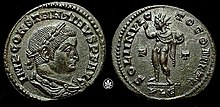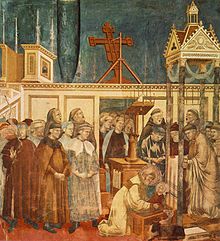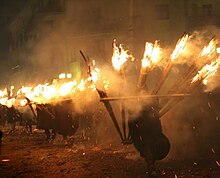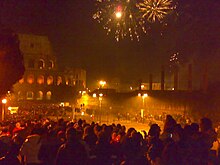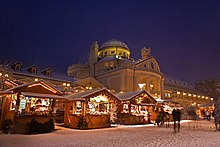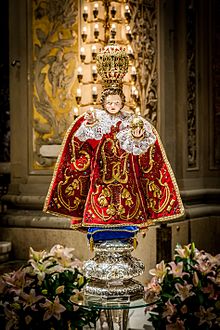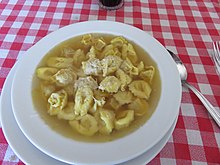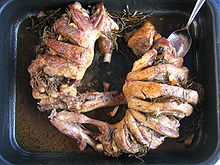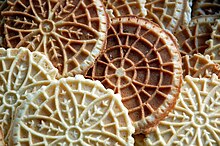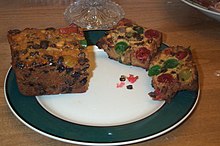Christmas in Italy
[12] Typical bearers of gifts from the Christmas period in Italy are Saint Lucy (December 13), Christ Child, Babbo Natale (the name given to Santa Claus), and, on Epiphany, the Befana.
The Catholic Church established December 25th as the official date for Christmas, aligning it with the Roman festival of Sol Invictus (the birthday of the "Unconquered Sun"), which was celebrated around the same time.
[16][17] From Aurelian onward, Sol Invictus often appeared on imperial coinage, usually shown wearing a sun crown and driving a horse-drawn chariot through the sky.
The custom is attributed to St. Francis of Assisi, who, in 1223, created the first living nativity scene in Greccio to help bring the Christmas story to life for the people.
Presents for children are left underneath the Christmas tree either by Santa Claus (called Babbo Natale) or, according to older traditions, by Baby Jesus himself.
On 6 January (Epiphany, in Italian Epifania) decorations are usually taken down, and in some areas female puppets are burned on a pyre (called falò), to symbolize, along with the end of the Christmas period, the death of the old year and the beginning of a new one.
It is quite common to attend Midnight Mass on Christmas Eve and practice the old custom of abstinence from meat on the day (but not fasting, which is observed by the Eastern Orthodox Church).
They may be elaborate affairs, featuring not only the classic nativity scene but also a mock rural 19th-century village, complete with artisans in traditional costumes working at their trades.
[41] In Valdichiana, Tuscany, it was customary for children, blindfolded, to hit the block with pincers, while the rest of the family sang a particular song, called "Ave Maria del Ceppo".
[45] Noteworthy are the Christmas markets at Piazza Navona in Rome,[46] in Verona, in Gubbio, in Alberobello, in Aosta, in Torino, in Asti, in Arezzo, in Florence, in Trieste, in Livigno, in Santa Maria Maggiore, Arco and in Cison di Valmarino.
[38] Typical bearers of gifts from the Christmas period in Italy are Saint Lucy (13 December), Christ Child, Babbo Natale (the name given to Santa Claus), and, on Epiphany, the Befana.
[13] Traditional bearer of gifts in some areas of northern Italy, such as Verona, Lodi, Cremona, Pavia, Brescia, Bergamo and Piacenza is Saint Lucy on the night between 12 and 13 December.
[56] A typical figure of Italian Christmas folklore is the Befana, depicted as an old witch on a broom, who appears as a bearer of gifts on 6 January, the day of the Epiphany.
This custom comes from the tradition of ancient Rome which involved the exchange of gifts of good wishes during the Saturnalia, a series of festivities that took place each year between 17 and 23 December, in honor of the god Saturn and preceding the day of the Natalis Solis Invicti.
According to Varro, the use was adopted as early as the first foundation of the city, set up by Titus Tatius who first caught, as good augur for the new year, the twig of a plant (arbor felix) located in the woods sacred to the goddess Strenia; from this derived the term strenae for the gifts of various types, including coins, to be exchanged in the feast of Saturnalia.
On the evening of 24 December the "Ndocciata" of Agnone is a parade of a great number of "'ndocce" (torches), structures with a typical fanwise shape, made of silver fir pinewood pallets.
The big bell of St. Anthony's Church is rung, and groups from the cities' districts (Capammonde and Capabballe, Colle Sente, Guastra, Onofrio, San Quirico) consisting of hundreds of carriers of all ages, light their torches to set off along the main streets which thus becomes what locals call a "river of fire".
[71] The attraction factors are the not too harsh climate, the cultural offer of the cities including museums, exhibitions and party initiatives, the rich gastronomy as well as the more affordable prices compared to other countries.
[71] Agnolini is a type of egg-based stuffed pasta originating from the province of Mantua (in the Mantuan dialect it is commonly called "agnulìn" or "agnulì"), oftentimes eaten in soup or broth.
Agnolotti pavesi is a type of egg-based stuffed pasta of the Lombard cuisine served hot or warm, typical of the Oltrepò Pavese, an area of the province of Pavia, in the Italian region of Lombardy.
[14] In particular, in Milan, around Christmas, four capons were raised, a deep-rooted tradition also reported in Alessandro Manzoni's The Betrothed,[14] generally ranked among the masterpieces of world literature.
[93] The classic Christmas recipe for this dish involves cooking the lamb in a pan, adding chopped sage and garlic and then wine mixed with vinegar.
[14] Panettone is an Italian type of sweet bread and fruitcake, originally from Milan, usually prepared and enjoyed for Christmas and New Year in Western, Southern, and Southeastern Europe, as well as in South America, Eritrea,[94] Australia, the United States and Canada.
[102] His recipe was the result of a reworking of the levà, a dessert with granulated sugar and almonds originally from Verona, to which Domenico Melegatti removed the covering and added butter and eggs to the dough.
[102] The dessert was so successful that several local imitators attempted to recreate it; the Veronese entrepreneur put a thousand lire up for grabs (which at the time corresponded to a small fortune) to anyone who managed to match his recipe.
Documents from 1205, conserved in the State Archive of Siena, attest that bread flavored with pepper and honey (panes melati et pepati) was paid to the local monks and nuns of the monastery of Montecellesi (modern Monte Celso, near Fontebecci) as a tax or tithe which was due on 7 February that year.
: pizzella) are traditional Italian waffle cookies made from flour, eggs, sugar, butter or vegetable oil, and flavoring (usually anise or anisette, less commonly vanilla or lemon zest).
Neapolitan mostacciolis were mentioned by Bartolomeo Scappi, personal cook of Pope Pius V as part of his pranzo alli XVIII di ottobre (18 October lunch).
These films are usually focused on the holidays of stereotypical Italians: bungling, wealthy and presumptuous members of the middle class who visit famous, glamorous or exotic places.
Generally, starting from 10 seconds before midnight, it is customary to count down until reaching zero, thus wishing a happy new year, toasting with spumante and watching or lighting fireworks, shooting firecrackers or guns loaded with blanks.


